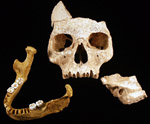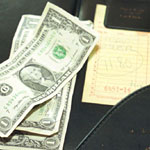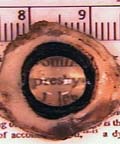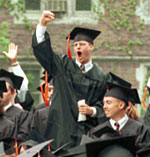Washington University faculty and staff make news around the world. Following is a representative sampling of media coverage from clippings and electronic sources received between July 1 and Sept. 30, 2003.

A “jaw-some” discovery
A research team co-directed by Erik Trinkaus, professor of anthropology in Arts & Sciences, has dated a human jawbone from a Romanian bear hibernation cave to between 34,000 and 36,000 years ago. That makes it the earliest known modern human fossil in Europe. Other human bones from the same cave — a temporal bone, a facial skeleton and a partial braincase — are still undergoing analysis, but are likely to be the same age. The results on the jawbone were published in the Sept. 30 issue of the Proceedings of the National Academy of Sciences. “The jawbone is the oldest directly dated modern human fossil,” said Trinkaus, the Mary Tileston Hemenway Professor of Anthropology. “Taken together, the material is the first that securely documents what modern humans looked like when they spread into Europe. Although we call them ‘modern humans,’ they were not fully modern in the sense that we think of living people.” The New York Times, BBC News, BBC News “Breakfast Show,” BBC.com, CNN.com, Los Angeles Times, Seattle Post-Intelligencer, Washington Times, The Times (London), The Telegraph (London), MX (Australia), La Tercera (Chile), Visao Magazine (Portugal), Archeo Magazine (Italy), Agence France Presse, Straits Times (Singapore), Science Illustrated (Denmark), FOCUS Magazine (UK), Bristol Evening Post (England) Science Daily, South Australia Advertiser, Voice of America, ABC Science Online (Australia), Discovery Channel, The Age (Australia), CNN, CNN International, Sydney Morning Herald (Australia), Hindustan Times (India), Newark Star Ledger (NJ), CTV (Canada), Yahoo! News, The Mirror (UK), Japan Today, Augusta Chronicle (GA), Billings Gazette (MT), Topeka Capital Journal (KS), Scientific American, MSNBC, Wired News, Innovations-report.com, Bloomington Pantagraph (IL), Salt Lake Tribune (UT), Centre Daily Times (PA), St. Louis Post-Dispatch, KMOV-TV St. Louis (MO)
Pay for DNA
It’s been three years since scientists completed a rough draft of the human genetic code, but nobody’s rushing out yet for a personal DNA analysis. That’s because the first draft took 12 years and cost billions of dollars. Today the cost has fallen, but only to around $50 million. The target price is orders of magnitude away: $1,000 for an individuals’ DNA sequence. That’s the price considered essential for giving scientists the thousands of sequenced samples they need to understand how genes work. Some scientists believe the old methods of sequencing DNA, though improving, will never produce a $1,000 genome. Elaine Mardis, assistant professor of genetics at the School of Medicine, said she worries that too many labs are releasing “data by press release” rather than subjecting the information to scientific review. “Honestly, it’s going to take us 10 to 15 years to get there,” she said of the $1,000 genome. “The non-scientific public is hearing this and saying that sounds really great, and people must be at that goal because they’re talking about it. That’s totally not the case. This is the plan for the future, and the future is not now.” New York Post, Boston Globe, Seattle Post-Intellingencer, China Post (Taiwan), ABC News.com, MSNBC News, Kansas City Star, Deseret News (Salt Lake City), Indianapolis Star, Daily Herald (Chicago), Times Daily, Wilmington Morning Star (North Carolina), Fort Worth Star Telegram, Wichita Eagle (Kansas), Sarasota Herald-Tribune (Florida), Providence Journal Bulletin, Arizona Republic, The Ledger.com, Fort Wayne News Sentinel (Indiana), Akron Beacon Journal (Ohio), Associated Press
Prosecutor misconduct
School of Law professor and former prosecutor Katherine Goldwasser notes that it was not safe to assume that “guilty pleas are absent prosecutorial misconduct,” while commenting on a study that examines state and local prosecutor misconduct. USA Today, Newsday, CBS News, CNN, ABC News, The Guardian (UK), Atlanta Journal Constitution, Kansas City Star, Duluth News Tribune, Akron Beacon Journal, Centre Daily Times (PA), Times Daily (AL), Biloxi Sun Herald, Grand Forks Herald, Tuscaloosa News, Columbus Ledger-Enquirer (GA), Macon Telegraph, Wichita Eagle, Fort Wayne Journal Gazette, Aberdeen American News, Rocky Mount Telegram, News Journal (TX), Belleville News-Democrat, Ventura County Star, Dayton Daily News, Fort Wayne News Sentinel, Wilkes Barre Weekender, Tacoma News Tribune, San Mateo County Times, Oakland Tribune, Helena Independent Record, Charleston Sunday Gazette Mail (WV), Charleston Gazette (WV), Montgomery County Record (PA), Tri-Valley Record (CA), Associated Press, St. Louis Post-Dispatch

Big bills, small tips
Psychologists in Arts & Sciences say you may be cheaper than you think. They have shown that the larger the bill, the smaller the tip percentage that food servers, hair stylists and cab drivers receive. Compiling data from nearly 1,000 tips left in restaurants, hair salons and with cab drivers, the researchers found that the percent of the tip actually decreases with the amount of the bill across all three tipping situations. Their findings also indicate that with bills more than $100, the percent of the tip levels off — if the bill is $200, the server is likely to receive the same percentage as if it were $100. Washington Times, Baltimore Sun, St. Louis Post-Dispatch, ABC News.com, ABC News radio, Web MD, Psychology Today, UPI, The Shorthorn (TX), Talk Radio 640 (Toronto).
Breaking into the top 10
Washington University — consistently ranked among America’s 20 best national universities — is now ranked in the top 10. The university is tied with Dartmouth College for ninth place in the annual rankings of America’s best colleges by U.S. News & World Report, which also ranked the Olin School of Business No. 14 among national undergraduate business administration programs. The Olin School was also ranked 12th by Forbes magazine and No. 28 by the Wall Street Journal/Harris Interactive survey of corporate recruiters. USA Today, CBSNews.com, Gallup Poll News, Dartmouth Online, Associated Press

Depression damage
Studying women with histories of clinical depression, investigators at the School of Medicine found that the use of antidepressant drugs appears to protect a key brain structure often damaged by depression. Previous research has shown that a region of the brain involved in learning and memory called the hippocampus is smaller in people who have been clinically depressed than in those who never have suffered a depressive episode. Now, researchers, led by Yvette Sheline, associate professor of psychiatry at the School of Medicine, have found that this region is not quite as small in depressed patients who have taken antidepressant drugs. “Our results suggest that if a woman takes antidepressants whenever she is depressed, depression would have less effect on the volume of her hippocampus,” Sheline said. “It is the untreated days that seem to affect hippocampal volumes.” National Public Radio, CBS News, Atlanta Journal-Constitution, CNN Headline News, Reuters, The Scotsman (Scotland), Connecticut Post (Bridgeport, Connecticut), Yahoo News, Scienceblog.com, WebMD, Chronicle of Neurology & Psychiatry, New York Sun, Science, Harvard Women’s Health Watch, American Chemical Society, Internal Medicine World Report, Reuters Health, HealthCentral.com, News 24 (South Africa), Ivanhoe, Pak Tribune (Pakistan), Drug Week, Biotech, Health & Medicine Week, HMG Worldwide, Pain & Central Nervous System Week, Mental Health Weekly Digest, Hartford Courant, St. Louis Post-Dispatch, Acumen Sciences News Magazine, Health Magazine, WCFT-TV Birmingham-Anniston-Tuscaloosa (AL), WHIO-TV Dayton (OH), KTVI-TV St. Louis (MO)

Temperature, not time, cures jet lag
Getting over jet lag may be as simple as changing the temperature — your brain temperature, that is. That’s a theory proposed by Erik Herzog, assistant professor of biology in Arts & Sciences. Herzog has found that the biological clocks of rats and mice respond directly to temperature changes. Health Day News, Connecticut Post (Bridgeport, CT) De Financieel Economische (Belgium), Evening Standard (London), Innovations Report (Germany), United Press International

SEC, Wall Street and corporate reform
The SEC, Wall Street and corporate reform remain top national news issues. School of Law dean Joel Seligman frequently commented on a variety of topics including the SEC’s election of outside directors, the first months of William Donaldson’s tenure as SEC chief, Wall Street conflict of interest issues, the LaBranche controversy, the future of the NYSE, and the resignation of the NYSE’s Richard Grasso. The New York Times, Money, Newsday, CBS Marketwatch, Washington Post, CNNfn, CNBC, Financial Times, USA Today, Forbes, MSN Money, Fort Worth Star Telegram, CNN Europe, Reuters UK, Quicken, St. Louis Post-Dispatch
Germs colonize to resist attack
A germ that causes stubborn urinary tract infections may be resistant to antibiotics because it invades the bladder cells and builds a fort-like colony that is impervious to drugs and attack from the body’s own immune system. Researchers at the School of Medicine found that electron micrographs showed Escherichia coli bacteria form a biofilm inside cells of the bladder cells of mice. “This biofilm is composed of bacteria unified into a colony to resist attack,” said Joseph Palermo, a clinical fellow in pediatric gastroenterology at the School of Medicine. “The bacteria rest in a matrix like eggs in a carton.” HLN-CNN, Boston Globe, St. Petersburg Times, Hamilton Spectator, Chattanooga Times Free-Press, HMG Worldwide, St. John’s Telegram, Deseret News, Windsor Star, London Free Press, OBGYN & Reproduction Week, Health & Medicine Week, Anti-Infectives Week, Women’s Health Weekly, Associated Press

Timing is everything
Biologists at Washington University in St. Louis have documented unprecedented levels of speciation and diversification in Caribbean anolis lizards. The discovery is completely unexpected and challenges the way evolutionary biologists think of evolution. Innovations Report (Germany), Environmental News Service, Science Daily News, ScienceBlog.com
Burst of the dot-com bubble
The technology world has been preoccupied in recent years by the boom-and-bust investment cycle — the collapse of the dot-com bubble, the sharp fall in share prices on the stock market and depressed spending by many large companies. But there has been no such boom-and-bust cycle in the embrace of digital technology and its promise of benefits for communication, automation and new forms of art. One area, among many, that has benefited from steady advances in computer simulation and analysis is research into the structure and workings of the human brain. “There has been an explosion in the use and impact of computation in recent years,” said David Van Essen, professor of anatomy and neurobiology at the School of Medicine. “And in many ways, it is still very early days in the use of digital tools in neuroscience.” The New York Times, International Herald Tribune (France), E-Commerce Times, Tech News World

The electronic leash
The author of a book offering advice to parents sending a child off to college says that the ubiquitous cell phone makes it easier for parents and students to keep in touch, but it also offers a challenge to the “letting-go” process. Karen Levin Coburn, assistant vice chancellor for students and associate dean for the freshman transition at Washington University in St. Louis, is co-author of Letting Go: A Parents’ Guide to Understanding the College Years, which provides a comprehensive, down-to-earth guide for parents experiencing the varying emotions of parenting a college student. The book, now in its newly released fourth edition, has sold more than 300,000 copies since first being released in 1988. “When we wrote our 1997 edition, very few people used cell phones. They just weren’t an issue,” Coburn says. “Now the majority of students have a cell phone and they’ve made a huge difference, pro and con, in the communication patterns between parents and students.” Northern Star Online, Daily Vanguard (OR)
Breathe easier?
The federal Medicare program has grappled with whether to pay for an aggressive and expensive lung operation that could offer a lifeline to tens of thousands of elderly patients. But health economists and medical experts say the treatment, however alluring, is part of an unsettling trend: new and even pricier treatments for common medical conditions that are part and parcel of aging — procedures that could potentially benefit tens of thousands of elderly patients, at a total cost that would far exceed the kind of prescription drug benefit now being considered by Congress. The procedure is an operation for people with severe emphysema, whose lungs are so scarred that they are constantly out of breath. The story of the operation is a case study of the thorny questions that Medicare administrators face as they try to live within the constraints of the $267.8 billion-a-year federal program. Some say the operation can transform lives. “If your parents had this condition, you would seek the operation for them,” said Joel Cooper, the Evarts A. Graham Professor of Surgery at the School of Medicine. The New York Times, Toronto Star, Deseret News, Chattanooga Times Free Press, Connecticut Post, WSIL-TV (Paducah, KY, Cape Girardeau, MO, Harrisburg-Mt. Vernon, IL)

Gerald Early
Korean War initiated armed services integration
The 50th anniversary of the signing of the armistice that ended the Korean War was commemorated in events around the world on July 27. Though the Korean War may have been overshadowed by World War II and the Vietnam War in the minds of many Americans, it had a dramatic effect on social change in the United States, says Gerald Early, the Merle Kling Professor of Modern Letters, professor of English and of African and Afro-American Studies, all in Arts & Sciences. Early, who is writing a book on the Korean War’s impact on integration and racial relations in the United States, contends that the Korean War was a driving force behind integration efforts during the early years of the civil rights movement. President Harry S. Truman issued an executive order integrating the armed services in 1948, something that had been recommended by his Commission on Civil Rights, but it was the Korean War, argues Early, which helped truly initiate that integration. Boston Globe
Chilling discovery
Therapeutic hypothermia — reducing body temperature below normal — has faded in and out of fashion for 50 years, but it received a big endorsement last month when the American Heart Association published a recommendation that some victims of cardiac arrest could be chilled. “Hypothermia is making an enormous resurgence,” said Michael Diringer, associate professor of neurology at the School of Medicine. “It’s hot stuff, pardon the pun.” Cooling is used now for certain types of neurosurgery that require cutting off blood flow to the brain. Cardiac bypass patients are sometimes cooled by chilling their blood also. But outside the operating room, chill therapy is rare. The New York Times, International Herald Tribune (France), Biotech Week, Pharma Business Week, Health & Medicine Week, Pain & Central Nervous System Week
Individual Development Accounts
Michael Sherraden, the Benjamin E. Youngdahl Professor of Social Development and director of the Center for Social Development at the George Warren Brown School of Social Work, discusses his concept of creating Individual Development Accounts for low-income families. The New York Times, The Record (NJ)
Martial arts therapy
At first glance, the eager-eyed children look like any other kids practicing their moves. Yet some wear leg braces. Muscle contractions contort the arms and hands of others. In this class, it doesn’t matter that the students have cerebal palsy, a movement disorder that garbles communication between the brain and muscles. They’re learning what none of them imagined they ever could: martial arts. The program is led by Janet Brunstrom, assistant professor of neurology at the School of Medicine. “All my life, people told me what I couldn’t do,” Brumstrom said. “They said I’d never walk, but I did. They said I didn’t belong in school, but I graduated high school as valedictorian at 16 and went on to become a pediatric neurologist. They thought I’d never marry or have a child, but I did. No one has the right to tell people with cerebal palsy what they can or can’t do.” Parade Magazine
Puritan punishment
In a tongue-in-cheek commentary, columnist Steve Chapman discusses the controversy over the Ten Commandments monument that had been in Alabama’s judicial building for two years before it was recently removed by judicial order. Chapman writes, “Justice Moore [who had installed the monument] says the roots of American law lie in God’s laws, and history supports him. The Puritans left England because the old country was insufficiently observant of the true faith. Once here, they made it their business to see that everybody lived right. … All sorts of things forbidden in the Commandments were sternly punished by the Puritans.” Chapman looked to David Konig, professor of history in Arts & Sciences, for examples. Writes Chapman, “David Konig, a historian at Washington University in St. Louis, says someone caught sampling forbidden delights might be forced to stand outside a church wearing a sign saying, ‘I am guilty of the heinous crime of fornication.’ … Mr. Konig says that in Puritan New England, merely traveling on the Lord’s day was asking for a stiff fine.” Chicago Tribune, Baltimore Sun

Use of a new polymer may eliminate the need for bifocals in some patients.
Turning back the clock for aging eyes
Bioengineers have devised a soft, supple substance that could turn back the clock for aging eyes no longer able to see up-close clearly without the aid of bifocals or contacts. The team, led by Nathan Ravi, associate professor of ophthalmology and visual sciences at the School of Medicine, predicts the pliant, jellylike material — injected through a minuscule cut — could replace time-worn lenses, which scientists believe harden over the years lessening their ability to change focus. The artificial lens could restore clarity to the hard-of-seeing, including patients with cataracts, the vision-obstructing clouding of the lens that affects an estimated one in seven seniors. The Times (London), Science Daily, Naples Daily News, Global News Wire, Innovations Report, KSL-TV Salt Lake City (UT), Copley News Service, United Press International
Orrin Hatch’s patriotic music CD
School of Law professor and ethics expert Kathleen Clark comments on HealthSouth’s deal to distribute Utah Sen. Orrin Hatch’s CD of patriotic and religious songs. Hatch lobbied Medicare for HealthSouth after discussing the company’s financial woes with Monzer Hourani, a contractor that helps design and build hospitals for HealthSouth. Hourani struck the CD distribution deal with Hatch in 2001. Wall Street Journal, Salt Lake City Tribune
DNA discovery
Genetic researchers say they have completed DNA sequencing of chromosome 7 — a chromosome associated with cystic fibrosis, deafness and several cancers. Richard Wilson, director of the Genome Sequencing Center at the School of Medicine, led the research conducted during the past five years at centers around the world. Researchers hope the information about the 1,150 genes they found will advance the study of acute leukemia, cystic fibrosis and a rare mental disorder called Williams-Bueren syndrome. National Public Radio’s “Science Friday,” Financial Times, MSNBC.com, The Australian, United Press International

FDA to collaborate with Olin
On the first anniversary of the launch of its strategic initiative to modernize the regulation of pharmaceutical manufacturing and product quality, the U.S. Food and Drug Administration has outlined a range of new steps, including a collaboration with the McDonough School of Business at Georgetown University and the Olin School of Business. The agency says the project should help it identify the factors that predict manufacturing performance to further refine its pharmaceutical manufacturing technology risk-based assessment. Pharma Marketletter. Washington Drug Letter
IVF link to birth defects
Mounting evidence that in vitro fertilization could be linked to a number of birth defects is generating controversy and concern in the field of fertility medicine. Scientists at the School of Medicine found that data from a national registry of patients with Beckwith-Wiedeman Syndrome showed that conception with in vitro fertilization was six times as common among the affected children as in the general population. Wall Street Journal, Newsday, Chicago Sun-Times
Striking times
School of Law professor and labor law expert Neil Bernstein comments on labor disputes around the country, including the grocery workers’ strike in St. Louis and the Verizon employees’ labor issues. Newsday, St. Louis Post-Dispatch

David Kilper/WUSTL Photo
What’s an MBA really worth?
A review of the state of Class of 1992 MBA alumni from Business Week’s Top 30 business schools notes that Washington University alumni, along with ’92 alums from the programs at Emory, Texas, and Indiana, gave their universities below-average scores in job advice and long-term career connections. Alums across the board among all 30 top business schools gave their schools low marks — a mere 5 out of 10. Business Week
Low-income phone access
George Warren Brown School of Social Work professor and poverty researcher David Pollio comments on the lack of phone access in low-income areas and its impact. The Advocate (LA), St. Louis Post-Dispatch

For love and money
Mark Rank, professor of social work at the George Warren Brown School of Social Work, comments on his study about the probability of becoming wealthy in America. Rank’s study finds that women have the best chance of becoming wealthy if they marry young and remain childless or stay single their entire lives. Men have the same chance of becoming wealthy whether they are married or single. The study also found that white married couples have an increased chance of becoming wealthy, but marriage did not significantly increase the chances that the average black man or woman would become well-off. Washington Post
To infinity!
Project Aria is a Washington University project that provides opportunities for K-12 students to actually send experiments on NASA flights. Begun as a local program by Washington University’s Keith Bennett, it now encompasses students from various states. Newsday, Associated Press
High health costs, risks
You’ve heard it before: Americans have the best medical care in the world. And the United States spends more money on health care than any other country. So doesn’t it follow that our care would be good? Not necessarily, according to a study in the New England Journal of Medicine. The chances of Americans getting proper care for a particular ailment is only about 50-50, the study found. “For a variety of reasons, many of the most effective medical technologies and treatments are not used,” said Michael Rich, associate professor of medicine at the School of Medicine. “That’s especially true of preventive and screening procedures.” Doctors in the United States, he says, are trained to focus on the sickest patients and less so on the chronic illness. Most physicians rely on memory and training to make the correct decisions, but with the explosion in medical knowledge and new technology, memory and training may not always be enough. Los Angeles Times
Corporate futures
School of Law professor Kathleen Brickey comments on the recovery of WorldCom — now MCI — and the company’s troubled future. Dallas Morning News
Relieving diabetic foot ulcers
Jeffrey Johnson, associate professor of orthopedic surgery in the School of Medicine, surgically lengthens the Achilles tendon or heel cord to relieve foot ulcers common in patients with advanced diabetes, which can cause nerve damage. “What we thought was that if we could lengthen this heel cord, we could reduce the pressure on the ball of the foot, which is the source of the ulcer in the first place.” Studies show that ulcers were 80 percent less likely to recur after seven months in patients with heel cord lengthening. WJBF-TV Augusta (GA), RNEW-TV Rochester (NY), KRQE-TV Albuquerque-Santa Fe (NM)
Want to find happiness in your golden years? Try volunteering
The latest study by researchers in the George Warren Brown School of Social Work shows older adults who volunteer just three hours a week live healthier and happier lives. They also had better assessments on well-being, self-rated health and depression. WSMV-TV Nashville (TN)